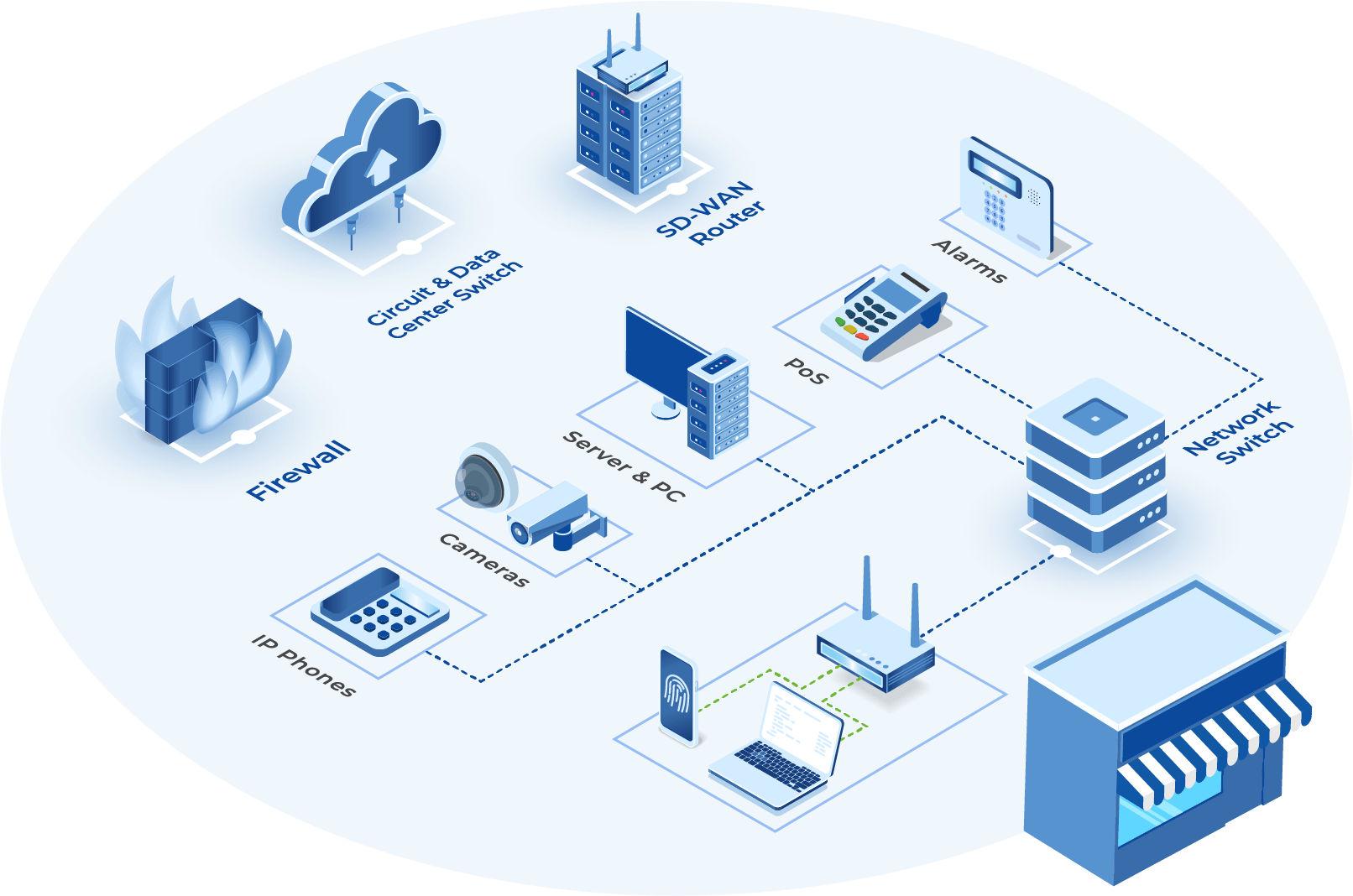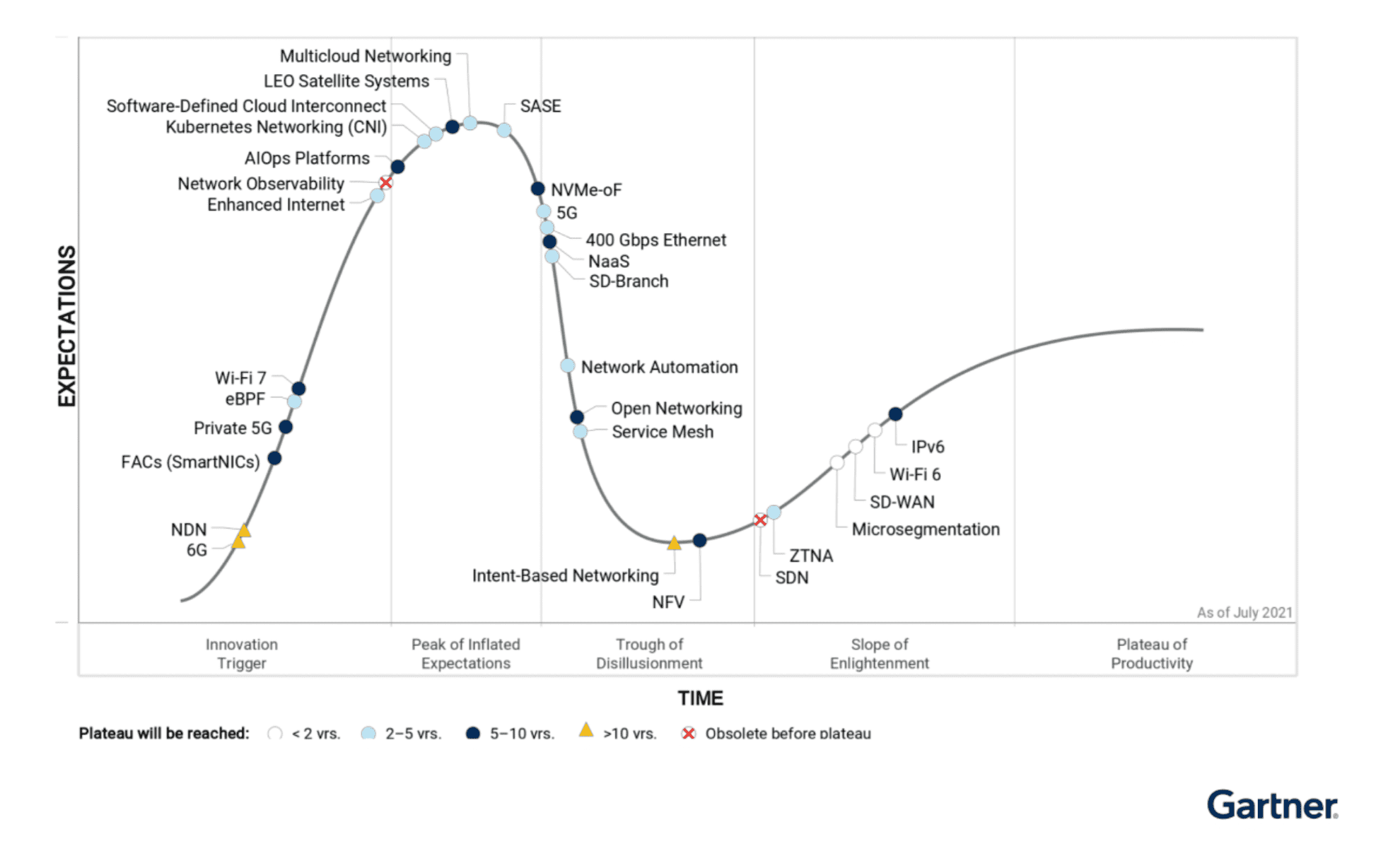What does a Managed Network Service Provider do?
A managed network services provider manages some or all aspects of design, implementation, support, maintenance, security, performance, and availability of the customers’ network infrastructure.
The components of the network infrastructure outsourced to a managed network services provider could include internet access, data circuits, customer premises equipment (CPE), cabling, covering LAN/WLAN and WAN.
The scope of these services can vary greatly depending on the size and complexity of the network to be managed and the customer’s choice of what aspects of the network services are to be outsourced.
Why Enterprises Rely on Managed Network Services Providers
1. In-House Network Management Skills Gaps
The demand for diverse network management skill sets and the ability to hire and retain employees with specialized network engineering skills can be a tough challenge for enterprises who would rather spend the time and money to strengthen core business operations and build products or services.
For example, a medium-sized retail chain or a restaurant chain looking to design and roll out an SD-WAN solution will probably need highly skilled network engineering talent during the initial design and roll-out phase. Once the solution is stable, the IT organization’s focus will be on ongoing maintenance and periodic updates.
Below is a sample of the high-level responsibilities required to manage a network in any mid-sized to large enterprise.
Router configuration
Switch configuration
Wireless access point configuration
Firmware updates
Software patches
Troubleshooting
Firewall configuration
Firewall firmware updates
Firewall software updates
Firewall rule management
Content filtering configuration
Content filtering maintenance
Compliance (PCI, SOX, etc)
Onsite installation
Onsite troubleshooting
Onsite repairs
Spare parts management
Warranty management
Asset management
Troubleshooting
Call center management
In most cases, it is impractical for enterprises to hire and retain in-house teams to perform all of the above tasks.
Unlike enterprises with periodic spurts in demand for network management skills, managed network services providers are able to deploy their teams across multiple client engagements giving them the ability to hire, retain and motivate a broad group of network engineers with diverse skill sets.
2. Difficulty in fixing network issues in a multi-vendor setup
Network technologies are increasingly becoming complex and involve the integration of solution components from a diverse set of hardware, software, and bandwidth providers. Invariably, implementing a sophisticated network connectivity backbone for optimal business application performance will involve a mix of third-party vendors and OEMs who specialize in different aspects of the solution.
For example, a typical retail store has numerous devices, applications or solutions that need to work together.

Troubleshooting performance issues with a POS machine at any location can involve packet tracing across multiple devices, networks, and the ISP serving the location. Coordinating troubleshooting involving multiple vendor entities can be a big drain on the internal IT team productivity and can even compromise routine tasks that the IT team is primarily responsible for due to lack of time.
With a managed network services companies, enterprises have a single point of contact and can do away with managing different SLAs across vendors. The problem of accountability and finger-pointing among providers is pronounced when there is no single entity to take ownership for all solution components – a role, managed network service providers are suitable for.
3. Limited Geographical Reach and Access to Partners
Retail chains, restaurant brands or franchisees, financial services, and hospitality brands manage hundreds of geographically dispersed locations or branches.
In spite of the COVID-19 pandemic, Most multi-location enterprises are expanding operations. According to Coresight Research, by March 2021, US retailers had announced 3199 store openings compared to just 3,298 openings for the whole of 2020[3].
Relying just on internal capabilities and skill sets to manage IT/network operations is not practical for a multi-location enterprise. It’s not feasible for internal network engineers to travel across states or international borders to set up or troubleshoot network issues at branch locations.
The quantum of work it takes to manage a network often drives enterprises to choose a managed network service provider as it’s often a question of prioritizing core business.
Most established managed network service providers have extensive partnerships and relationships with network carriers, hardware OEMs, and network software vendors that are useful to tackle large-scale network challenges. In addition, some managed service providers also have a local presence in multiple states and geographies thereby offering customers an extensive support network.
4. Network Security Threats and Compliance Challenges
In addition to managing a complex security environment, enterprises have to also comply with various data management regulations that are directly related to how secure and compliant the underlying network is.
- 27% of cybersecurity professionals declared that each security technology demands its own management and operations, straining many organizations’ resources.
- 51% of organizations have a problematic shortage of cybersecurity staff and skills.
- 24% of survey respondents say their organization needs different solutions for different infrastructure environments such as cloud applications, data centers, endpoints, networks to name a few. This creates operational inefficiencies and leads to security loopholes.
For example, a retail or restaurant chain may have to comply with the following regulations:
- Payment Card Institute (PCI)
- Health Insurance
- Portability and Accountability Act (HIPAA)
- European General Data Protection Regulation (GDPR)
- California Consumer Compliance Protection Act (CCPA)
- Personally Identifiable Information (PII)
- Sarbanes Oxley (SOX)
According to the Cost of Data Breach Report 2021, system complexity and compliance failures were found to be the top causes that amplify the cost of a security breach. Businesses with low levels of compliance incurred $2.3M more in costs associated with security breaches when compared to businesses with higher levels of compliance[5].
Managed network service providers have the ability to address complex network security and compliance challenges holistically. Some of them specialize in designing network solutions that address industry-specific compliance regulations or security requirements such as those applicable for healthcare.
5. Network Cost Reduction Challenges
The true cost of network cost-cutting:
Depending on the brand, category, location, or size, a retail location generates sales in the range of $1,000-$10,000 per day with big-box retailers earning a lot more. Degraded network performance or availability as a result of cost-cutting programs can have serious consequences.
- POS terminals cannot process a debit/credit transaction
- Online orders and phone orders can go out of service
- Customers will encounter service issues and delays
There are other serious productivity and security implications as well.
Even if the POS system has the capability to store and forward credit authorizations, the network has to be up and running before the transactions are settled. The fall-back option also elevates the security threat if the credit card data is not handled the right way.
Employees end up spending a lot of time with the IT help desk and the IT teams in turn spend a lot of time troubleshooting the issue across multiple vendor-provided infrastructures.
All these issues drive up the cost of business, hurt sales, negatively impact customer satisfaction and employee productivity.
In general, managed network services providers have significant leverage and buying power with equipment manufacturers as they place large orders to cater to different customer projects.
The scale of operations results in lower technology spend.
Some managed network services vendors offer a flat rate billing for standard maintenance and monitoring services. This model simplified the IT operations for the customer and offers predictability in forecasting costs as the customer expands to new locations.
A managed network services provider can further optimize costs and set up a financial model that’s tailormade for every customer’s capital expenditure or operating expense goals or priorities.
Large capital spend can be softened by creating a model where the cost of equipment and implementation are expensed over the life of the contract improving cash flow.
6. Flexibility to Execute Business Transformation
Case Study –
Why Network is Critical for Digital Transformation
A fast-growing restaurant chain that was managing the network infrastructure in-house faced major challenges during COVID-19 as there was no standardized network infrastructure or bandwidth availability across the various locations.
- Network downtime and degraded performance were frequent issues and the in-house IT team did not have the resources to troubleshoot the problems with any predictability.
- The customer experience at every touchpoint – phone ordering, tracking online orders, curbside pickup, and POS transactions, was below par.
- Employees spent a lot of time on the phone troubleshooting issues instead of focusing on the customer.
- Network downtime directly impacted sales and customer service.
The customer chose to standardize and upgrade the network infrastructure, added redundant internet lines, all managed by Interface. This strategy paid off as the restaurant chain was able to eliminate network downtime thereby driving up customer satisfaction and sales.
The internal IT team could now focus on the IT transformation roadmap instead of getting bogged down with day-to-day operations.
7. Reduced Complexity for Predictable Outcomes

As you can imagine, by the time an enterprise stabilizes the implementation of a brand new network solution, there are a dozen other technologies promising better results and greater flexibility to ramp up business operations!
The rapid evolution of networking technologies also gives rise to increased complexity as enterprises are forced to rely on point solutions if the primary solution provider is behind the curve in critical emerging technologies.
Managing complex systems is expensive and often requires access to niche talent which increases the cost of network operations.
That’s why enterprises are embracing managed network services providers as they attempt to keep pace with emerging network technologies while minimizing implementation and support risks.
For example, there is already a significant uptick in enterprises relying on managed network service providers for SASE. According to Gartner, “By 2024, 30% of enterprises will adopt cloud-delivered SWG, CASB, ZTNA and branch office firewall as a service (FWaaS) capabilities from the same vendor, up from less than 5% in 2020.”
Multi-location enterprises have complex networks that are often difficult to upgrade. Managed network services providers with proven expertise and the backing of the solution providers or hardware vendors are well suited to pilot untested technologies, demonstrating ROI before implementing the solution on a large scale.
Identifying the most relevant technology and successfully implementing it is just one side of the coin. The ROI of the new technology implementation is dependent on predictable outcomes on an ongoing basis.
Network service providers with the required domain expertise and process maturity can ensure the ongoing success of any new solution implementation that’s measured through service level agreements (SLAs).
In general, SLAs cover the following aspects of service delivery:
- Scope of services
- Performance metrics
- Reporting procedures
- Roles and responsibilities/division of responsibilities
- Escalation process
- Penalties and remedial steps including legal recourse
- Engagement governance
SLAs are meant to provide clarity on the success or failure of the engagement and in some cases can also be tied to business metrics. Enterprises should definitely put in the effort upfront to have well-defined SLAs in place and also review the performance for streamlining the process and graduate to a more meaningful set of SLAs as the business evolves.
Managed Network Service Providers Can Be Game Changers
As enterprises pivot to new business models and accelerate digital transformation, there is a major demand for implementing complex solutions. Solution complexity brings with it an array of challenges that makes hiring a managed network services provider a necessity.
With proper due diligence, enterprises can gain significant competitive advantages by partnering with a managed network services provider.
- Maximize ROI on technology investments by reducing capital expenses and focusing on business outcomes.
- Build a lean and agile IT team that has the capacity to bring to bear specialized expertise offered by the managed network services vendor.
- Validate new and emerging technologies before scaling or making additional investments thereby minimizing implementation risks.
- Build custom network management solutions that are designed for unique business workloads and customer demands.
- Ensure the success of mergers or acquisitions even when inheriting legacy network infrastructure from the acquired entity.
- Put into practice the lessons learned by the managed services vendors who are exposed to network challenges faced by other customers.
Get the Interface Advantage
Interface’s managed network services can help multi-location enterprises leapfrog competition and delight customers. Talk to our experts.



